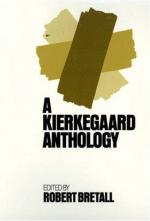
|
| Name: _________________________ | Period: ___________________ |
This test consists of 15 multiple choice questions and 5 short answer questions.
Multiple Choice Questions
1. What is Kierkegaard undergoing after his conversion?
(a) A terrible revolution.
(b) A change of heart.
(c) The flu.
(d) A physical transformation.
2. How old is Kierkegaard at the age of his conversion?
(a) 26 years old.
(b) 35 years old.
(c) 25 years old.
(d) 14 years old.
3. What is the name of the best known section of Stages on Life's Way?
(a) The last supper.
(b) The banquet.
(c) The restaurant.
(d) The meal.
4. What does Kierkegaard think will happen with what his family received?
(a) It will disappear.
(b) It will continue.
(c) It is something of the past.
(d) It will come from time to time.
5. What does Kierkegaard say truth is discovered in?
(a) Dialectics.
(b) Faith.
(c) The heart.
(d) One self.
6. Who does Kierkegaard write his pseudonymous work for according to Fear and Trembling?
(a) Regina.
(b) God.
(c) The public.
(d) Himself.
7. Who's letter does Either/Or contain a series of?
(a) Socrates'.
(b) Judge William's.
(c) Hegel's.
(d) Regina's.
8. Where does the idea of Repetition derive from?
(a) The life of Christ.
(b) Regina's life.
(c) The rise of Christian dogma.
(d) Kierkegaard's own life.
9. What does Kierkegaard do before leaving for Berlin at the star of Either/Or?
(a) Goes to church.
(b) Breaks off his engagement with Regina Olsen.
(c) Writes a book.
(d) Buries his dog, Maximus.
10. What does Robert Bretall say Kierkegaard is in the Two Edifying Discourses?
(a) A poet.
(b) A fiction writer.
(c) A theopolian.
(d) A liar.
11. What happens to Kierkegaard and Regina's relationship?
(a) Kierkegaard fires her.
(b) Regina dies.
(c) Kierkegaard breaks off the engagement.
(d) Kierkegaard replaces her.
12. What city does Kierkegaard live in according to Robert Bretall in Chapter 5?
(a) Munich.
(b) Paris.
(c) Berlin.
(d) London.
13. What does Robert Bretall say is difficult to discern in Kierkegaard's writing?
(a) Who he is talking to.
(b) If the love of Christ guides him.
(c) If he is Christian.
(d) Which aspects of Kierkegaard are present.
14. What does Kierkegaard think Fear and Trembling will do to the reader?
(a) Make him think.
(b) Terrify him.
(c) Amuse him.
(d) Make him convert.
15. What does Kierkegaard say of the realms discussed in Stages on Life's Way?
(a) They all need Christ to make sense.
(b) They are all divided in 3.
(c) They are all concrete forms of existance.
(d) They can all be mastered.
Short Answer Questions
1. What book sets the stage for Kierkegaard's mature work?
2. When does Kierkegaard write Repetition?
3. What is Kierkegaard aware of concerning Fear and Trembling?
4. What pseudonym does Kierkegaard use for The Fragments?
5. What topic does Either/Or end with?
|
This section contains 422 words (approx. 2 pages at 300 words per page) |

|




